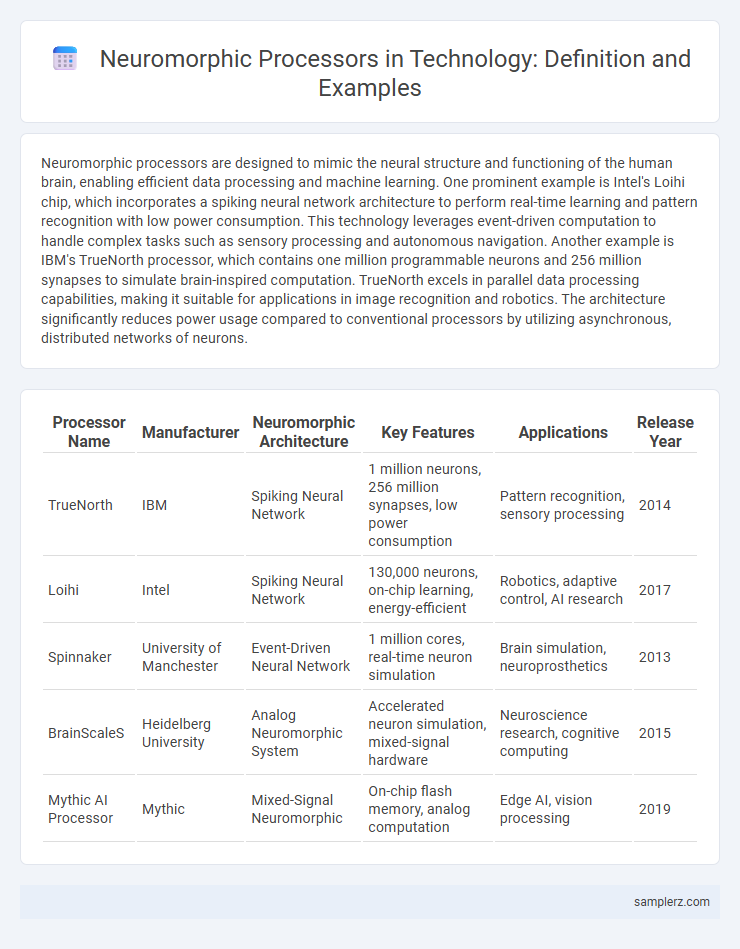Neuromorphic processors are designed to mimic the neural structure and functioning of the human brain, enabling efficient data processing and machine learning. One prominent example is Intel's Loihi chip, which incorporates a spiking neural network architecture to perform real-time learning and pattern recognition with low power consumption. This technology leverages event-driven computation to handle complex tasks such as sensory processing and autonomous navigation. Another example is IBM's TrueNorth processor, which contains one million programmable neurons and 256 million synapses to simulate brain-inspired computation. TrueNorth excels in parallel data processing capabilities, making it suitable for applications in image recognition and robotics. The architecture significantly reduces power usage compared to conventional processors by utilizing asynchronous, distributed networks of neurons.
Table of Comparison
| Processor Name | Manufacturer | Neuromorphic Architecture | Key Features | Applications | Release Year |
|---|---|---|---|---|---|
| TrueNorth | IBM | Spiking Neural Network | 1 million neurons, 256 million synapses, low power consumption | Pattern recognition, sensory processing | 2014 |
| Loihi | Intel | Spiking Neural Network | 130,000 neurons, on-chip learning, energy-efficient | Robotics, adaptive control, AI research | 2017 |
| Spinnaker | University of Manchester | Event-Driven Neural Network | 1 million cores, real-time neuron simulation | Brain simulation, neuroprosthetics | 2013 |
| BrainScaleS | Heidelberg University | Analog Neuromorphic System | Accelerated neuron simulation, mixed-signal hardware | Neuroscience research, cognitive computing | 2015 |
| Mythic AI Processor | Mythic | Mixed-Signal Neuromorphic | On-chip flash memory, analog computation | Edge AI, vision processing | 2019 |
Introduction to Neuromorphic Processors
Neuromorphic processors, such as Intel's Loihi and IBM's TrueNorth, mimic the neural architecture of the human brain to enhance computational efficiency and power consumption. These processors use spiking neural networks to process information asynchronously, enabling rapid pattern recognition and adaptive learning in real-time applications. Neuromorphic technology promises significant advancements in AI, robotics, and sensory processing by leveraging brain-inspired computing models.
Key Principles of Neuromorphic Computing
Neuromorphic processors mimic the architecture and dynamics of the human brain by using spiking neural networks and event-driven computation, which enables energy-efficient parallel processing. Key principles include synaptic plasticity for learning, asynchronous communication between neurons, and co-location of memory and processing units to reduce latency. This approach leads to significant improvements in real-time data processing and adaptive learning capabilities in smart devices.
Intel Loihi: Pioneering Neuromorphic Hardware
Intel Loihi exemplifies cutting-edge innovation in neuromorphic processors by emulating the human brain's neural architecture to enhance computational efficiency and learning capabilities. This chip integrates spiking neural networks to process information asynchronously, significantly reducing power consumption compared to traditional processors. Intel Loihi's adaptable design accelerates advancements in AI applications, robotics, and sensory processing by enabling real-time, energy-efficient neural computations.
IBM TrueNorth: Mimicking the Human Brain
IBM TrueNorth is a neuromorphic processor designed to replicate the architecture and efficiency of the human brain by utilizing 1 million programmable neurons and 256 million synapses on a single chip. This technology enables low-power, real-time sensory processing suitable for applications such as pattern recognition and machine learning. TrueNorth's event-driven, parallel processing model allows it to perform complex cognitive tasks while consuming only 70 milliwatts of power, setting a new standard in brain-inspired computing.
SpiNNaker: Large-Scale Neural Network Simulator
SpiNNaker is a state-of-the-art neuromorphic processor designed to simulate large-scale neural networks with exceptional efficiency. Its architecture integrates millions of ARM cores capable of real-time brain modeling, enabling breakthroughs in neural computation and cognitive research. SpiNNaker's scalable and parallel processing model mimics biological neural networks, driving advancements in artificial intelligence and neuromorphic engineering.
BrainScaleS: Analog Neuromorphic Integration
BrainScaleS exemplifies analog neuromorphic integration by mimicking synaptic and neuronal dynamics on silicon to accelerate brain-inspired computing. The processor employs wafer-scale integration and mixed-signal circuits to achieve high-speed emulation of neural networks with real-time plasticity. This architecture enables efficient simulation of large-scale neural models for applications in cognitive computing and artificial intelligence.
Neurogrid: Energy-Efficient Neural Computation
Neurogrid exemplifies neuromorphic processors by mimicking brain-like neural networks to achieve energy-efficient computation. It integrates analog circuits with digital communication to simulate one million neurons using just a few watts of power. This approach significantly reduces energy consumption compared to traditional processors, enabling advanced neural modeling and real-time cognitive computing.
Applications of Neuromorphic Processors in AI
Neuromorphic processors, such as Intel's Loihi and IBM's TrueNorth, enable efficient AI applications by mimicking brain-like neural architectures to perform complex pattern recognition and sensory processing tasks with ultra-low power consumption. These processors are particularly effective in autonomous robotics, real-time data analysis, and edge computing where rapid decision-making and energy efficiency are crucial. By leveraging event-driven computation and parallel processing, neuromorphic chips accelerate AI workloads like image recognition, natural language understanding, and adaptive learning systems.
Comparing Neuromorphic vs Traditional Processors
Neuromorphic processors, such as Intel's Loihi and IBM's TrueNorth, mimic the brain's neural architecture to enable highly efficient parallel processing and real-time learning, contrasting sharply with traditional Von Neumann processors that rely on sequential computation and separate memory-storage units. Neuromorphic designs excel in energy efficiency and adaptive learning tasks, offering significant advantages for artificial intelligence applications over conventional CPUs and GPUs. While traditional processors dominate general-purpose computing, neuromorphic chips lead in specialized fields like pattern recognition, sensory processing, and autonomous systems due to their scalable spike-based communication and event-driven architecture.
Future Prospects of Neuromorphic Processors
Neuromorphic processors, inspired by the architecture of the human brain, are revolutionizing the field of artificial intelligence with their ability to process data in parallel and consume significantly less power than traditional processors. Future prospects include advancements in edge computing, where neuromorphic chips enhance real-time decision-making capabilities in autonomous vehicles, robotics, and IoT devices. Continued research aims to improve scalability and integration, enabling widespread adoption in AI-driven applications requiring efficient sensory processing and adaptive learning.

example of neuromorphic in processor Infographic
 samplerz.com
samplerz.com